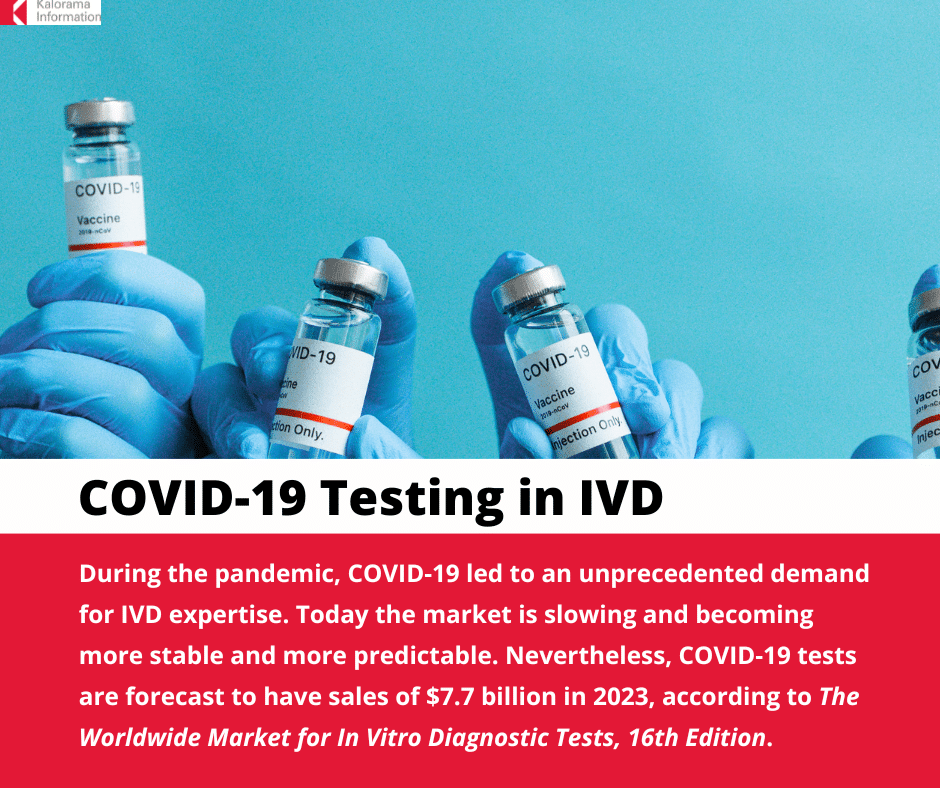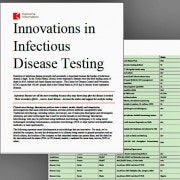How Globalization and Climate Change Impact COVID-19 and the IVD Market

COVID-19 hospitalizations in the U.S. have spiked in recent weeks amidst the advent of yet another new variant and the impending arrival of updated booster shots for a fall vaccination campaign. This late summer spike in infections comes after months of declines in COVID-related hospitalizations and deaths.
The spike is poised to impact the in vitro diagnostic (IVD) industry where the COVID-19 market is slowing and becoming more stable and more predictable. COVID-19 tests are forecast to have sales of $7.7 billion in 2023 compared to $29.6 billion in 2022, according to The Worldwide Market for In Vitro Diagnostic Tests, 16th Edition by leading medical market research company Kalorama Information.
During the pandemic, COVID-19 led to an unprecedented demand for in vitro diagnostic expertise. The urgency and swift response to COVID-19 testing solutions resulted in a strong uptick in instrument-installed bases for both immunoassay and molecular infectious disease diagnostic platforms. The capital purchase of these systems has expanded use overall and extended capabilities beyond the pre-COVID-19 era. This is particularly true of advanced molecular, molecular point-of-care (POC), and automation systems that may not have been purchased without the urgency and funding as a result of the pandemic.
COVID-19-driven demand for IVD expertise also led to a flurry of activity for PCR, NGS, and serology-based rapid-test products. As a result, the market has opened several new areas of advancements including microfluidic technologies, next-generation sequencing, microarrays, and a growing significance of precision medicine including companion diagnostics and multiplex testing that target significant growth opportunities.
Growth opportunities will persist as long as scientists continue to see a shift in the geographical expansion of infectious diseases. Whether climate change is man-influenced or a natural occurrence of nature, infectious diseases are appearing well outside of where they are expected to be, in months when they are not expected, and at levels of intensity that are not anticipated.
As far as COVID-19 goes, there is no scientific evidence that either weather or climate have an influence on the transmission of COVID-19 disease and there is no evidence that climate change made the emergence or transmission of COVID-19 more likely. Even though climate change did not cause the emergence of COVID-19, it could indirectly make the effects of a future pandemic worse. This is because it undermines the environmental conditions we need for good health—access to water, clean air, food, and shelter—and places additional stress on health systems.
COVID-19 can directly be attributed to globalization, world travel, urbanization, and population increase. Globalization and urbanization are driving the spread of infectious diseases, but higher temperatures and more extreme weather events have also influenced the range and intensity of infectious diseases.
Researchers agree that it is hard to predict the impact of climate deviations on disease patterns. Additionally, surveillance programs are underfunded and inconsistent–based on immediate need. For example, in 1999, when West Nile arrived there was public outcry over lapsed mosquito surveillance and a surge of new funding. As the threat subsided, there was a return to the status quo. Then 20 years later, Zika comes along and everybody wonders why we are not ready for it. So, the scenario begins again with an uptick in surveillance programs and increased funding.
Infections that are transmitted through water, through food, or by vectors such as mosquitoes and ticks, are highly sensitive to weather and climate conditions. The warmer, wetter, and more variable conditions brought by climate change are therefore making it easier to transmit diseases such as malaria, dengue fever, chikungunya, yellow fever, Zika virus, West Nile virus, and Lyme disease in many parts of the world.
To be better prepared, better surveillance is needed along with better communication among hospitals and local health authorities to help improve readiness for outbreaks. Pathogens such as Lyme disease or V parahaemolyticus are on the move. Early warning systems and prevention are key to protecting the population.
Clinical labs will continue to be important participants in the early warning system by developing real-time surveillance systems and rapid point-of-care tests that will inform these surveillance systems and make them more robust.
For more information, purchase The Worldwide Market for In Vitro Diagnostics here.
About The Worldwide Market for In Vitro Diagnostics
This report, The Worldwide Market for In Vitro Diagnostics, now in its 16th Edition, details IVD activity on a global scope. The report looks at the entirety of the in vitro diagnostic market and makes forecasts, accesses trends, and scrutinizes vendor activities.
The report discusses tests and technologies that are currently available and those that are expected to take their place. Generally, current products and technologies establish the standard of care and its value to payers. Meanwhile, market analysis in this report covers world markets for in vitro diagnostics, with an emphasis on key regions: North America, Japan, and Western Europe.
The report also covers more than twenty core market segments, including:
- Blood Bank Molecular
- Blood Bank Screening
- Blood Grouping/Typing
- Circulating Tumor Cells
- Clinical Chemistry
- Coagulation
- Continuous Glucose
- COVID-19
- D-dimer
- Drugs of Abuse
- HbA1c Immunoassays, Lab-Based
- Hematology
- Histology/Cytology
- HPV, molecular
- Immunoassays, Infectious Disease
- Immunoassays, Other
- Mass Spectrometry
- Microbiology (ID/AST)
- Molecular Microbiology
- Nucleic Acid Assays
- POC Professional
- POC, OTC diabetes
- POC, OTC Other
Why Kalorama Information?
Kalorama Information, part of Science and Medicine Group, is the leading publisher of market research in healthcare areas, including in vitro diagnostics (IVD), biotechnology, medical devices, and pharmaceuticals. Kalorama Information produces dozens of reports a year. The firm offers a Knowledge Center, which provides access to all published reports.
Kalorama Information’s studies feature independent primary research conducted by experienced analysts. Researchers build their market analysis independently from published databases, validating data with inside industry contacts and extensive secondary research, so you can have confidence that you’re getting your information from the most trusted source in the industry!





